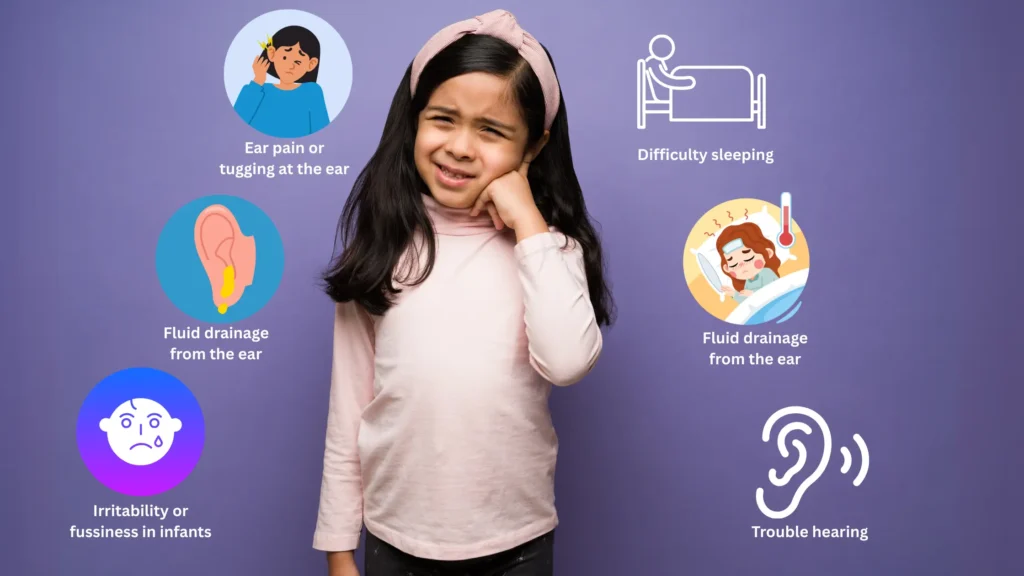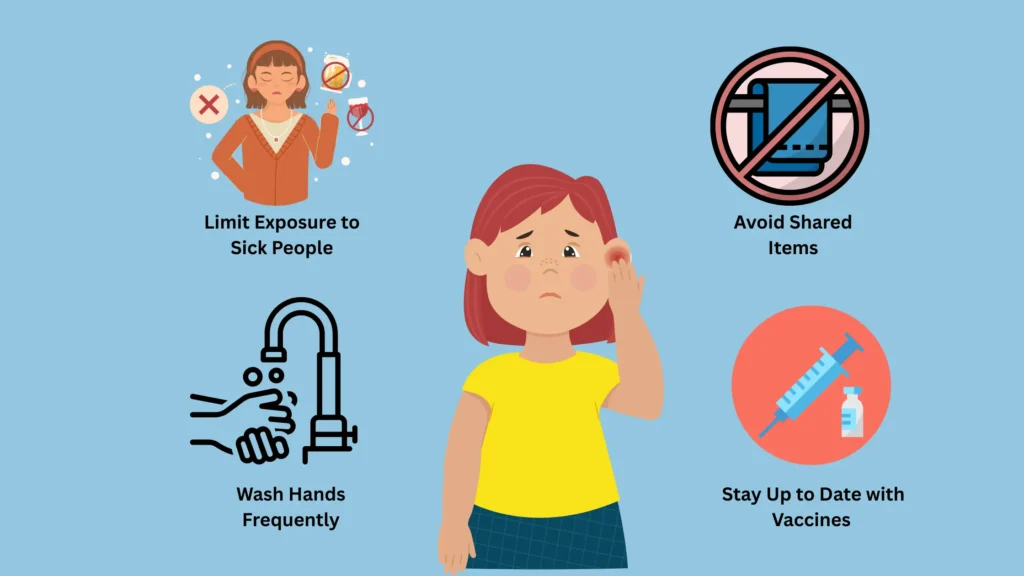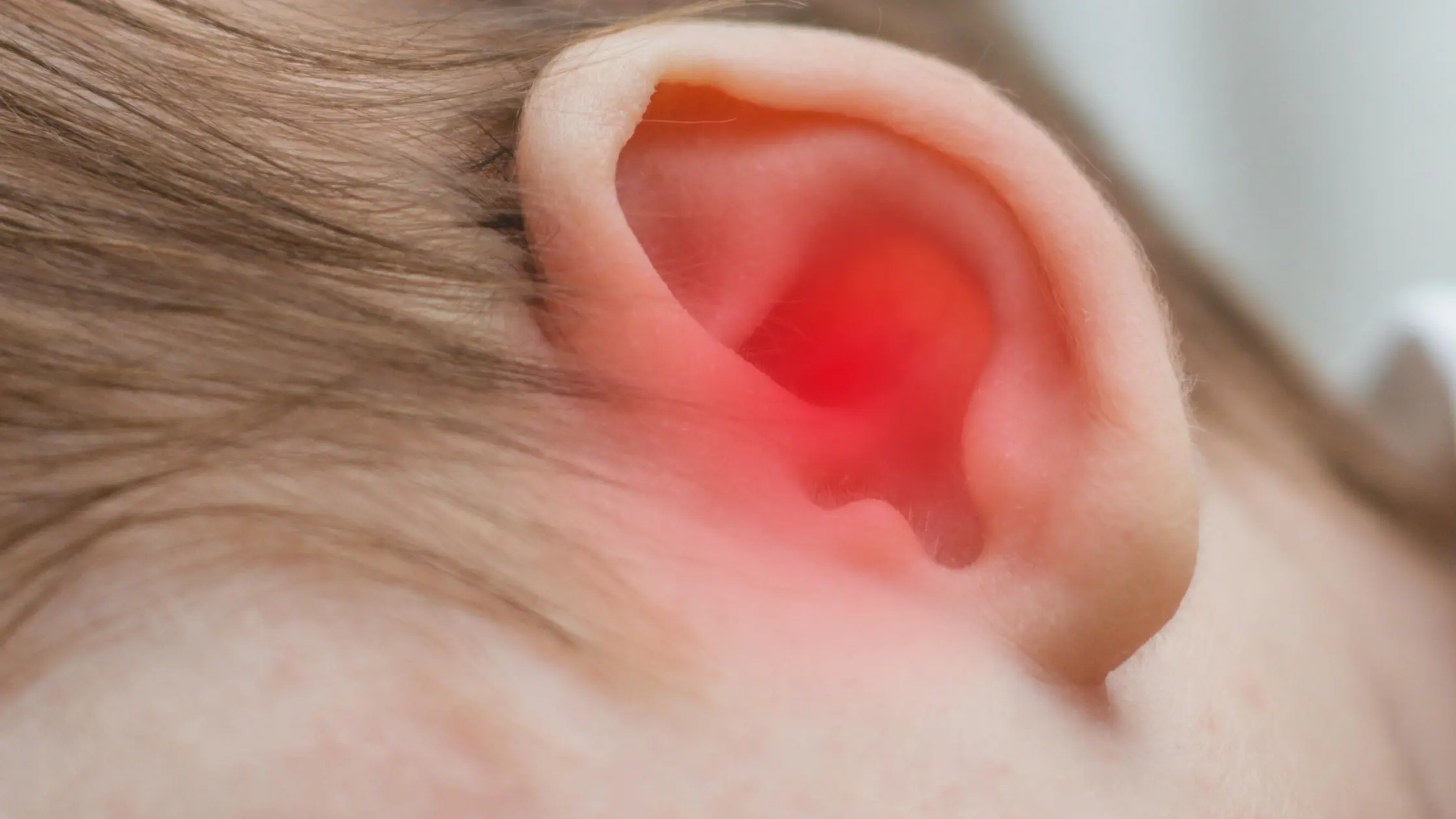Is an ear infection contagious? Ear infections, especially in babies, toddlers, and young children, are common occurrences. However, understanding their contagious nature is crucial for parents and caregivers. Regardless of whether your child has mild or severe ear infection, the risks of transmission and how to avoid them, can be useful in keeping your family healthy and safe.
Table of Contents
- What is an Ear Infection?
- Symptoms of Ear Infections
- Is an Ear Infection Contagious?
- How Contagious is an Ear Infection?
- Preventing the Spread of Ear Infections
- Can a Baby or Toddler Catch an Ear Infection from Another Child?
- Can You Get an Ear Infection from Swimming?
- FAQs on Is an ear infection contagious or Not
- Conclusion: Is an ear infection contagious?
What is an Ear Infection?
to clarify the question “Is an ear infection contagious or not?” the basic about ear infection should be known. Ear infections are of two types:
- Otitis Media (Middle Ear Infection): The infection will take place when the middle ear behind the eardrum gets inflamed. It is more prevalent among children, mainly toddlers and babies and a viral infection, such as flu, cold, or respiratory infection, can be the cause of it. Due to inflammation, fluid buildup may occur resulting in pain, pressure, and even the temporary loss of hearing.
- Otitis Externa (Outer Ear Infection): This is also commonly known as the swimmer ear and it attacks the outer ear canal. It is normally caused by bacterial infection where water gets into the ears as a result of swimming in dirty water or even inserting something in the ear. Among the symptoms are itchiness, redness and even fluid from the ear.
Symptoms of Ear Infections

Ear pain or tugging at the ear
A common sign of discomfort, children may pull or tug at their ear due to pain from an infection, especially when moving or touching it, as it intensifies with pressure or changes in position. This can be a reflex action, and parents should be alert to this sign as it can help identify ear infections early.
Fluid drainage from the ear
Ears infected will bulge fluid, which is the indicator of a bacterial or viral ear infection, and it tends to have a bad smell or pus that appears as a result of infection or bacteria in the ear canal. The ear area can also experience inflammations as a result of this drainage causing more discomfort and even reddening.
Irritability or fussiness in infants
Babies who can’t express their pain often become more fussy or irritable when experiencing an ear infection, especially if they are uncomfortable or crying more than usual, showing frustration with feeding or soothing attempts. Infants may also have trouble settling down or staying calm due to the persistent discomfort.
Difficulty sleeping
The pain in the ear may increase when a person lies down, and children may experience difficulty falling or staying asleep especially because of pressure or pain in the ear that is enhanced by the lying down posture at night time. The sleep disturbances may result in additional irritability and tiredness, which influence general mood and condition of the child.
Fever
A fever often accompanies ear infections, especially if caused by a viral infection like a cold or the flu, and can lead to further discomfort or lethargy, leaving the child feeling weak and unwell while battling the infection. Fever may also increase in severity, especially in the early stages of an infection, and may require fever-reducing medication.
Trouble hearing
A temporary loss of hearing due to fluid buildup or inflammation of the ears may occur in the middle ear increasing the difficulty of children responding to the sound or hearing clearly and hence children might be unaware of their environment or any verbal signals. It has the potential to impede the communication and social interactions, which alter the behavior and make the young children develop frustration.
When your child exhibits some of these symptoms, then it is advisable to seek the services of a pediatrician to help in diagnosing and treatment, you should note that correct treatment is important as it can save the life of a child.
Is an Ear Infection Contagious?

Is an ear infection contagious? The simple answer is yes, but with the condition depending on the cause. The infections of the ears may be contagious since ear infections are commonly associated with viral or bacterial infections which may be transmissible like when involved with fluid discharge or respiratory droplets.
Viral Ear Infections
Viral ear infections are commonly caused by viruses such as the flu or common cold. These infections are highly contagious because the viruses that cause them can spread easily through respiratory droplets from coughing, sneezing, or even talking. The virus can also spread through direct contact, like touching contaminated surfaces and then touching the eyes, nose, or mouth.
Bacterial Ear Infections
Bacterial ear infections are typically less contagious than viral infections but can still spread, especially if associated with an upper respiratory infection such as a cold or flu. The bacteria from the upper respiratory tract can travel to the middle ear and cause an infection. In these cases, the infection may spread through respiratory droplets or direct contact.
However, a bacterial ear infection is less likely to spread directly compared to a viral one. The infection usually becomes non-contagious after 24-48 hours of antibiotic treatment. Once the child has been on antibiotics for at least a day, the risk of spreading the infection significantly drops.
How Contagious is an Ear Infection?
Ear infections, though common, can be contagious, but the degree of contagion depends on whether the infection is caused by a virus or bacteria. Both types can spread through various means, but viral infections are generally more contagious than bacterial ones.
Viral Ear Infections
- Transmission through Respiratory Droplets: When a child with a viral ear infection coughs, sneezes, or even talks, the virus-laden droplets can be inhaled by others nearby, potentially leading to the spread of the infection. If an infected child coughs or sneezes, they may release viruses into the air, where they can be inhaled by others in the vicinity, increasing the chances of passing the infection along.
- Touching Contaminated Surfaces: Children often touch surfaces contaminated with respiratory droplets, such as toys, doorknobs, or shared objects. These viruses can survive on surfaces for a while, and if another child touches the same surface and then touches their face (eyes, nose, mouth), they can contract the infection. The presence of mucus in the ear or nasal passages further facilitates the transfer of germs.
- Accompanying Symptoms: Ear infections caused by viral infections often come with other symptoms like runny noses, fevers, or sore throats, all of which are highly contagious. These symptoms amplify the risk of spreading the infection to others.

Bacterial Ear Infections
- Transmission through Respiratory Droplets: While bacterial ear infections are less likely to spread directly through the air like viral infections, they can still be passed along through respiratory droplets. If a child has a cold or flu (which are caused by bacteria) along with the ear infection, the bacteria can be transmitted to others through coughing, sneezing, or touching surfaces contaminated by these droplets.
- Contact with Infected Surfaces: Similar to viral infections, bacteria from ear infections can be transferred by touching contaminated surfaces. If your child has an upper respiratory infection, they can easily pass the bacteria to others by touching toys, shared spaces, or other children.
- Antibiotic Treatment: The risk of spreading a bacterial ear infection decreases once the child has been on antibiotics for 24-48 hours. The antibiotics help to kill the bacteria, making the child less contagious and significantly reducing the chance of passing the infection to others.
Key Differences in Contagion
- Viral Ear Infections: Spread easily through respiratory droplets and contaminated surfaces. Highly contagious, especially when accompanied by symptoms like runny noses and coughs. Contagious for as long as symptoms persist, typically up to a week.
- Bacterial Ear Infections: Less contagious, but still transmissible through respiratory droplets. The risk of spreading decreases significantly after 24-48 hours of antibiotic treatment.
Preventing the Spread of Ear Infections

Wash Hands Frequently
One of the best ways to prevent the spread of ear infections is by washing hands regularly. Make sure your child washes their hands thoroughly with soap and water, especially after coughing, sneezing, or touching potentially contaminated surfaces. Using hand sanitizers when soap and water are not available can also be effective in minimizing the spread of germs.
Limit Exposure to Sick People
If your child has an ear infection caused by a viral infection, it’s crucial to limit their exposure to others, especially during the contagious period. Try to keep them away from school, daycare, or other public places until they’re no longer symptomatic. Keeping your child in a well-ventilated space and avoiding crowded areas can further reduce the risk of spreading the infection.
Avoid Shared Items
Teach your child not to share personal items like towels, toys, or cups, which can spread bacteria and viruses. Regularly disinfect frequently-touched items in your home, such as doorknobs, remote controls, and toys, to reduce the chance of contamination.
Stay Up to Date with Vaccines
Certain vaccines, such as the flu vaccine, can help protect your child from infections that may lead to ear infections. Vaccines like the pneumococcal vaccine also reduce the risk of bacterial infections that could affect the ear. Make sure your child’s vaccinations are up-to-date to help prevent infections that can lead to ear complications.
Can a Baby or Toddler Catch an Ear Infection from Another Child?
Admittedly, babies and toddlers are the most prone to ear infections since their immune systems are not yet fully developed to fight off infections. Ear infections transmitted through contact with infected individuals are highly contagious especially in settings such as daycare, preschool or school that the children spend most of their time together in close contact. Close interaction, such as sharing toys, utensils, or coughing and sneezing, combined with poor hygiene practices, significantly increases the risk of transmission. As a result, it’s easier for babies and toddlers to catch ear infections from other children in these settings.
Can You Get an Ear Infection from Swimming?

The water in which one swims can also reveal bacteria or viruses in the ear canal, causing otitis externa (swimmer ear); swimming in a public pool or other body of infected water increases the risk of this. The disease happens when the ears accrue moisture, which allows growth of bacteria. Unlike middle ear infections, otitis externa is not typically contagious, as it is caused by external factors like dirty water or prolonged exposure to moisture. However, the infection can cause discomfort, itching, redness, and fluid drainage in the ear.
FAQs on Is an ear infection contagious or Not
1. How long is an ear infection contagious in toddlers?
Toddler ear infections may be contagious as long as the child was still symptomatic which would be about 7-10 days in the case of a viral infection. Until the activity of antibiotics, bacterial ear infections are contagious and may last up to 24-48 hours
2. Can ear infections spread through the air?
Yes, viral ear infections can spread through the air when someone coughs or sneezes. The viruses that cause the infection, such as those responsible for colds or the flu, can be transmitted through respiratory droplets.
3. How can I help my toddler feel better with an ear infection?
To help alleviate the discomfort of an ear infection in your toddler, you can:
- Offer pain relief medications like acetaminophen (Tylenol) or ibuprofen (Advil), as recommended by your pediatrician.
- Apply a warm compress to the affected ear to soothe pain.
- Keep your toddler hydrated and offer fluids frequently.
4. Are ear infections more common in babies?
Indeed, infants have an increased risk of ear infections, because they have weaker immune systems and the shapes of their ear canals which can seal fluid and get infected.
5. Can a child with an ear infection go to daycare?
It’s best to keep a child with an active ear infection home from daycare to prevent spreading the infection to other children. They can return once they’ve been treated with antibiotics (if bacterial) and no longer have symptoms.
Conclusion: Is an ear infection contagious?
Is an ear infection contagious? Yes, it can be, especially when caused by a virus. Babies, toddlers, and kids are particularly vulnerable, and proper hygiene and preventive measures are key to reducing the risk of spreading infections. Always seek medical advice if you suspect your child has an ear infection, and follow your healthcare provider’s guidance on how long they should remain isolated from others to prevent transmission. By understanding the contagious nature of ear infections and taking the necessary precautions, you can help protect your child and others from unnecessary illness.
Explore more on Pregnancy Must –
